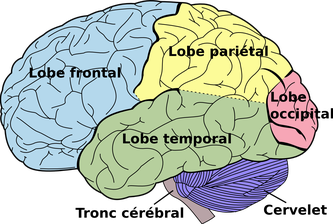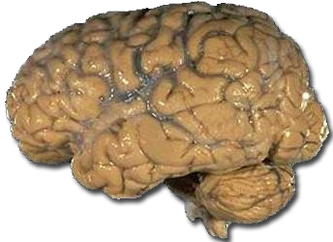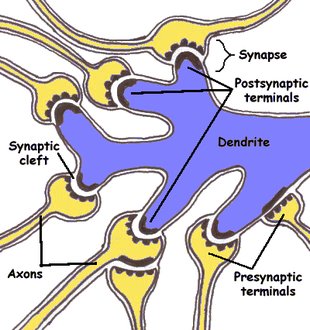We are now entering a crucial area of the nervous system, all the purposes and parts behind the job. Here, we will examine specifically what the nervous system does and how all these parts work together to act as one.
Parts and Purposes
Neurons
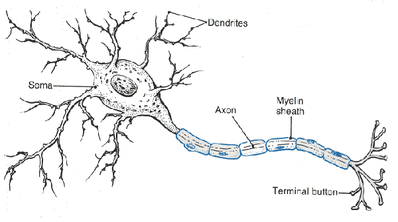
Neurons: Neurons send electrical impulses, which get carried by the nervous system. The cell that transmits impulses are called neurons. Neurons can be divided into three main groups:
-Sensory (carries impulses from organs to the spinal cord.)
-Motor (takes impulses from the brain and the spinal cord and sends them to muscles and glands.)
-Interneuron (connects the sensory and motor together.)
Neurons are the basic unit of the nervous system. Nerves are composed of neurons that carry impulses. A nerve cell can divided into many different parts, including:
Axon: a long fiber that carries impulses away from the cell body.
Axon terminal: where the axon ends, where the starting of synapse occurs.
Myelin sheath: the insulating membrane, which surrounds the axon (plays important role when it comes to the rate of the electrical impulses).
Cell body: the largest part is the cell body, which contains the nucleus and cytoplasm (the most metabolic activity happens here).
Nucleus: found in the cell body, the center of the nerve cell.
Dendrites: carry impulses from the environment and other neurons to the cell body.
-Sensory (carries impulses from organs to the spinal cord.)
-Motor (takes impulses from the brain and the spinal cord and sends them to muscles and glands.)
-Interneuron (connects the sensory and motor together.)
Neurons are the basic unit of the nervous system. Nerves are composed of neurons that carry impulses. A nerve cell can divided into many different parts, including:
Axon: a long fiber that carries impulses away from the cell body.
Axon terminal: where the axon ends, where the starting of synapse occurs.
Myelin sheath: the insulating membrane, which surrounds the axon (plays important role when it comes to the rate of the electrical impulses).
Cell body: the largest part is the cell body, which contains the nucleus and cytoplasm (the most metabolic activity happens here).
Nucleus: found in the cell body, the center of the nerve cell.
Dendrites: carry impulses from the environment and other neurons to the cell body.
Spinal Cord
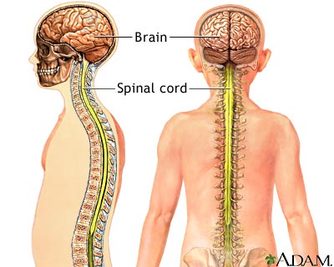
Spinal Cord: The spinal cord is the main communication link between the brain and the body. There are 31 pairs of spinal nerves from the spinal cord connecting to the brain. This allows impulses to travel from anywhere in the body to the brain. Think of it as a game of ‘telephone,’ sending messages from nerve to nerve. In order for the message to reach it's destination, or the brain, all parts and nerves must work together. Because the spinal cord is apart of the nervous system, which follows the COL "regulation", the spinal cord works by responding to changes in the environment. Reflexes, allow the body to respond to danger in it's internal and external environment.
Brain
Brain: Known as the "central nervous system" the brain is the most important part of the nervous system. The main switching unit of the central nervous system, or the control center of the body, contains around 100 billion neurons. The brain is broken into four main parts: The Cerebrum, The Cerebellum, The Medulla, and the Thalamus Hypothalamus. Each part has a specific job to help the body function, such as storing memories/ideas, coordinating movement and even controlling conscience or voluntary behavior.
Synapses
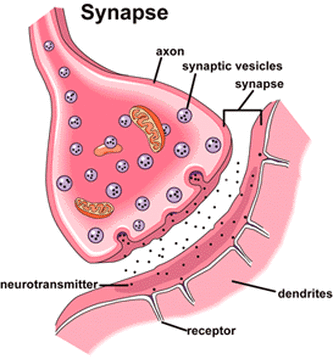
Synapses: is the location at which a neuron can transfer an impulse to another cell. The method works like this:
*Presynaptic axon refers to the neuron that is sending the impulse, and the postsynaptic neuron refers to the neuron receiving the impulse.*
-Information from one neuron flows to the next neuron through synapse.
-The synapse contains a gap where neurons are separated.
-At the end of a presynaptic neuron, an impulse reaches an axon terminal, which usually gets passed onto another cell.
-In this terminal, tiny vesicles contain neurotransmitters. The vesicles enter as little sacs, and form into bigger sacs containing the neurotransmitters as it gets closer to the synapse. The name of these sacs are "synaptic vesicles".
-At the end of the axon terminal, the synaptic vesicles will reach the end of presynaptic axon and enter into the synapse, releasing neurotransmitters (chemicals). This happens because after the neurotransmitters dock at the "docking proteins" to wait to move on, an electrical impulse comes and pushes the neurotransmitters through the neuron membrane.
-The neurotransmitters disperse, where they enter the synapse and try to find a receptor to latch onto, located on the surface of the connecting neuron. Neurotransmitters will either be accepted by the postsynaptic neuron and connect to a specialized site called a receptor, or it will be rejected.
-When the neurotransmitters are released from the presynaptic neuron, they bind to specific receptors on the outside of the postsynaptic neuron.
-The impulse that has just been transmitted by synapse, enters the postsynaptic terminal into the dendrite. Here, dendrites receive the majority of the nervous system signals through synapse.
-Here, the whole process repeats, continuing to send impulses via synapse.
*Presynaptic axon refers to the neuron that is sending the impulse, and the postsynaptic neuron refers to the neuron receiving the impulse.*
-Information from one neuron flows to the next neuron through synapse.
-The synapse contains a gap where neurons are separated.
-At the end of a presynaptic neuron, an impulse reaches an axon terminal, which usually gets passed onto another cell.
-In this terminal, tiny vesicles contain neurotransmitters. The vesicles enter as little sacs, and form into bigger sacs containing the neurotransmitters as it gets closer to the synapse. The name of these sacs are "synaptic vesicles".
-At the end of the axon terminal, the synaptic vesicles will reach the end of presynaptic axon and enter into the synapse, releasing neurotransmitters (chemicals). This happens because after the neurotransmitters dock at the "docking proteins" to wait to move on, an electrical impulse comes and pushes the neurotransmitters through the neuron membrane.
-The neurotransmitters disperse, where they enter the synapse and try to find a receptor to latch onto, located on the surface of the connecting neuron. Neurotransmitters will either be accepted by the postsynaptic neuron and connect to a specialized site called a receptor, or it will be rejected.
-When the neurotransmitters are released from the presynaptic neuron, they bind to specific receptors on the outside of the postsynaptic neuron.
-The impulse that has just been transmitted by synapse, enters the postsynaptic terminal into the dendrite. Here, dendrites receive the majority of the nervous system signals through synapse.
-Here, the whole process repeats, continuing to send impulses via synapse.
Neurotransmitters

Neurotransmitters: In the terminal, tiny vesicles contain neurotransmitters. Neurotransmitters are the chemicals used by a neuron to transmit an impulse to another cell.
Receptors
Receptors: found on the connecting cells membrane, receptors are the place were the neurotransmitters attach to send impulses onto the postsynaptic neuron, or the neuron receiving the impulse.
